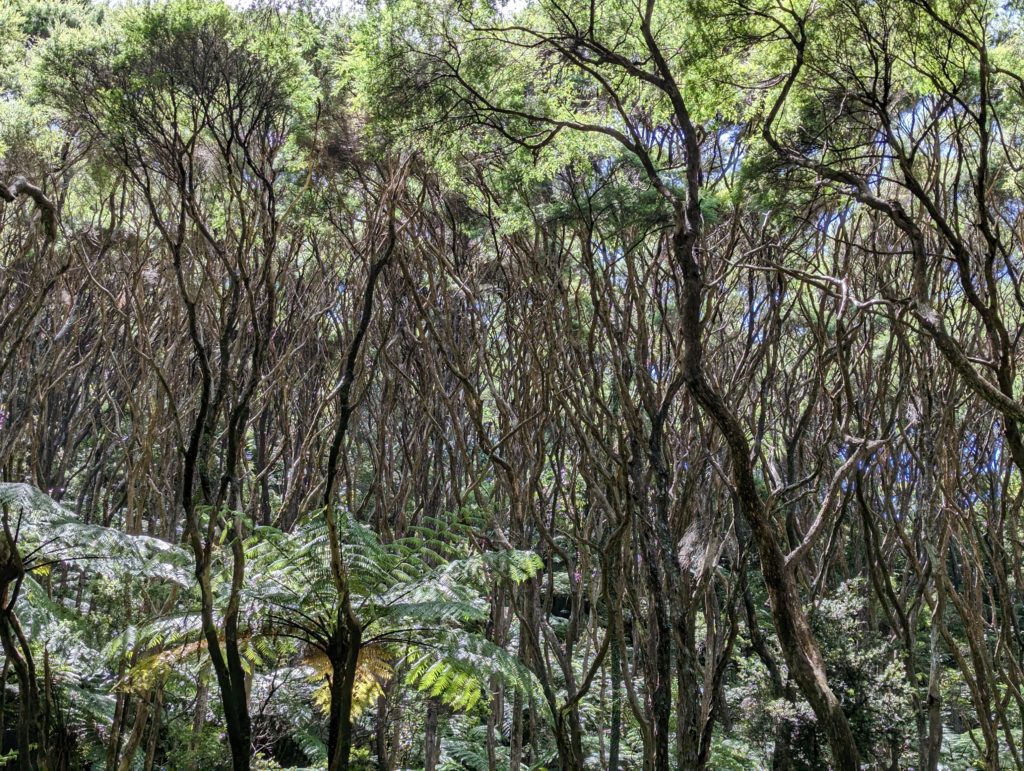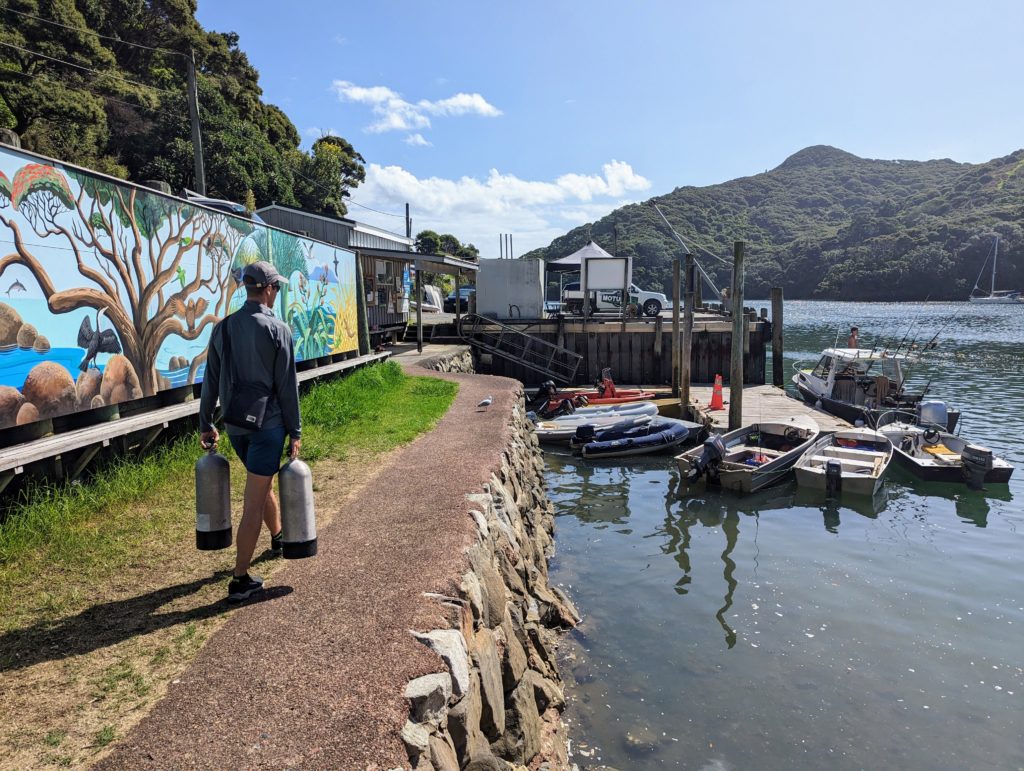We sailed out of (giggle) Tutukaka with an offshore breeze giving us a nice broad reach and light seas. Turning a little out of our way brought us by the Mokohinau group for a little view, but otherwise it was a pretty uneventful, comfortable sail. At this point it was February 6th, and we were starting to see indications that a cyclone would be coming to visit the following week. But we had at least a few days of good weather to work with ahead of the storm, and forecasts that far in advance are never set in stone, so we resolved to keep an eye on the models and find a hidey-hole before any weather came in. (There will be several of these screenshots here; look at the slider at the bottom to see how far in the future we’ve scrolled.)






We sailed into Port Abercrombie on Great Barrier just as a research vessel was pulling out. Barrier felt a little reminiscent of the Marquesas, with big hills jutting sharply out of the water — though of course it’s much colder here.


With a wind shift coming, we wanted a reasonably protected spot, so we pulled into Rarohara Bay, aka Port Fitzroy. And who did we see but Django, which seems to be sitting unoccupied everywhere we go. We had a bit of a search for a suitable spot to anchor, as most of the shallow water is filled with unoccupied private mooring balls. But Villa has plenty of chain, and we got it done.




Around sunset, we were visited by a couple of ducks, who seemed like they might be looking for a handout. We didn’t feed them, but we did call out Captain to have a good stare. They were totally unfazed by our giant predator, and just stared right back as they floated by.





We slept in in the morning, or at least some of us did. While Jazz was asleep, another boat came by and told Andrew they’d seen our ad, and could they have a tour? And would we like to come diving later? Sadly our tanks were empty, and they were gone long before we could have roused the sleeping crew. Once we did get our acts together, we took the dinghy in to a surprisingly nice floating dock attached to the Glenfern Sanctuary. (As with most of Barrier, Captain was not welcome ashore and had to stay behind.)


We had a lovely walk through the woods, looking at the various ferns and knobbly trees, and mostly hearing but not seeing the many birds. We were amused to see the sign announcing the change from “walking track to tramping track standard”; this is apparently a thing. It seemed to us that the whole thing was pretty well flooded out. Captain would not have liked that first section.







In the middle of the loop, a bridge leads out into a little treehouse viewing platform.



Then the descent takes you across a cleared hilltop with a view down to Port Fitzroy, and out the harbor mouth towards the mainland.







When we got back, we tried to do a little paperwork. We rarely ever use paper and Captain was eager to help, so we gave him a decoy sheet. That seemed to mollify him. We also managed to get our dive tanks filled, though sadly we would never end up using them. The forecast had shifted, and now showed a lot more energy in the storm as it traveled south, missing the mainland but hitting Great Barrier pretty hard. Worrying, but lots of time to get out of the way; we got in touch with the marina where we were going to do showings after the storm, and asked about maybe getting into our slip a little early.



The next morning’s model run was not much better, although Captain remained unconcerned.


After our ritual morning coffee and weather report, we took a hike on the opposite side of the bay. We passed by some temporary and permanent waterfalls and got a little view down to Villa through the trees.









When we got back down to the beach, we found the tide had (predictably) gone out, leaving us a walk across some texturally interesting seaweed. Fortunately there was a reasonable slope so we didn’t have too far to carry Dinkus back to the water.



The next morning’s report showed the eye passing over the mainland. In some ways that’s worse than the stronger winds from before, because as the wind shifts, you need protection from all the wind directions. That limits your choice of harbors; we resolved that we would check into the well-protected marina. Still, we didn’t have to go just yet! On recommendation of a couple we met on the hike, we motored around the corner of the island to a secluded spot that promised tropical white sand. The view of the coastline along the way was also pretty nice, with many interesting rock formations.












The anchorage was indeed sandy, with shallow water (we love our shallow boat!) and striking red cliffs. We had finally looked up New Zealand’s drone rules, and found them to be depressingly restrictive, to the point where we decided not to even carry our drone on our trip to the south island. Fortunately, this was a secluded spot, with no other houses or people we couldn’t fly over or photograph, and we were able to take a legal flight as long as we stayed over the water and not the land. New Zealand, country of rules.





We took this time all by ourselves in a beautiful place to relax. Just kidding! We did another boat project, replacing the dying cockpit lights with a new set. The old and new are both “waterproof”, but it seems that a boat really needs a deeper level of protection than that.




Jazz, egged on by Saskia, psyched herself up all day for a “free swim” in the cold water, only to find that the shallow sand had warmed it a few degrees from “freezing” to a merely “bracing” 71°F. Captain did a good job patrolling the boat, keeping the birds off and making sure we knew he wanted some of our dinner.



The forecasts continued to support our decision to head to the mainland. One interesting thing to note is how different the path of the storm looks in GFS vs in ECMWF. GFS, “the American model”, has the storm traveling south much faster, and staying closer to shore, than the “Euro” model. Regardless, it was now the night of the 10th, and with the storm starting to pick up in the next few days, it was time to start moving. Fortunately, with the wind blowing from the east ahead of the storm, we would be able to sail in.


We had a nice lazy morning first, though, because when it’s your last night at anchor for a while you should try to sleep in.


